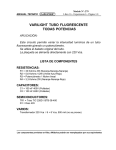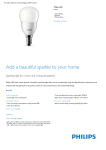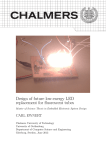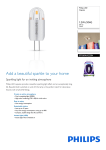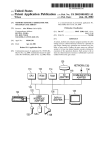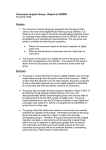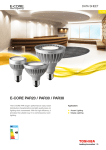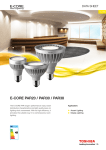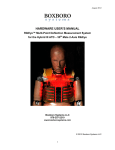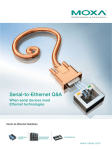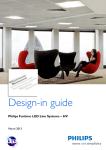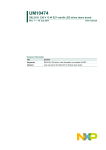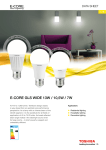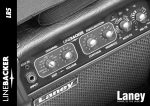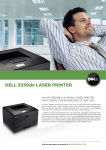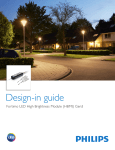Download design-in guide
Transcript
Design-in guide Philips Fortimo LED Integrated spot module Gen2 dimmable 1 Contents Introduction Designing luminaires on the Fortimo Integrated spot gen2 module Applications Difference between Gen 1 and Gen 2 Basic information of the module 3 3 3 4 5 Norms and Standards 20 Safety 20 Approval Environment 20 20 Photo biological safety aspects UV and IR radiation 20 21 Electromagnetic compatibility Humidity 21 21 Exposure to direct sunlight Vibration and shocks 21 21 Structure Product range 5 5 Nomenclature of the Fortimo Integrated spot gen2 System approach 6 6 Recommendations 6 IP codes, dust and moisture protection Glow-wire test 21 22 7 End-of-life behavior Disposal 22 22 Optical design Minimum and maximum flux 7 Light distribution Spectrum 7 9 Color consistency Lumen maintenance Mechanical design General Fixation Electrical design General Characteristics of the driver 9 11 12 12 12 14 14 14 Class I Inrush current 14 15 Thermal design 16 General 16 Test requirements How to measure Th 16 16 Air flow 16 Dimming 17 General 17 Rules to calculate the LED load Installation 17 18 Points of attention Dimmerlist 18 19 2 Introduction Thank you for choosing the Philips Fortimo Integrated spot gen 2 module. In this guide you will find all relevant information to design new luminaires based on this module. More information or support If you require any further information or support please consult your local Philips office or visit: • Fortimo modules www.philips.com/fortimo • General OEM info www.philips.com/oem Designing luminaires based on the Fortimo Integrated spot gen2 module The use of LEDs brings additional considerations for luminaire manufacturers compared with traditional lamps. For example, how can you ensure that your new luminaire can take advantage of LED improvements without having to redesign it each time? Also, how do you ensure that your new luminaire has a sufficient heat sink, and how do you deal with variations in flux and/or color. Fortunately, the Fortimo Integrated spot gen2 module addresses these issues to ensure easy adoption of LED technology for high lumen packages of 600 lm. The Fortimo LED Integrated spot gen2 module is ideal for smart LED redesigns of existing low-voltage 50W halogen fixtures thanks to the integrated driver, optics and heatsink. It allows a fast time to market. The module is ideal for recessed, ceiling, suspended and wall surface spot luminaires requiring high quality, long lasting light. . Applications The Fortimo Integrated spot gen2 module is intended for general lighting 3 applications in semi professional markets such as: • Hospitality, healthcare and cruise ship applications: corridors, service, areas, lobbies, lounges, restaurants, reception areas, waiting rooms • Home applications: fixed, recessed, pendant and ceiling luminaires, shelf lighting, under-cabinet lighting • Retail applications: shop windows, wall-washing, accent and display lighting, corridors, changing rooms • Office applications: corridors, meeting rooms Other markets can be addressed only if the relevant luminaire regulations are respected (e.g. EN60598). Furthermore, the Integrated spot gen2 module is IP20 classification, so if you would like to develop a Fortimo-based luminaire for outdoor use, you are responsible for proper IP protection and approbation. Also, consult us if you wish to deviate from the design rules as described in this guide. Future advances in bare LED efficacies will be incorporated into the Fortimo Integrated spot gen2 module. Which means you can take advantage of increasing efficacies, without changing the dimensions, shape of the module. This is a futureproofed approach to enables you to plan and design new luminaire ranges that can be marketed (without redesign) for years to come. Difference between Fortimo Integrated spot module Gen1 and Gen2 Gen 1 Gen 2 6 leds 4 leds Earth wire not included Earth wire included Cable length = 157 mm Cable length = 220 mm Non dimmable LE Dimmable Standard lifetime 25K Hrs Increased lifetime 50K Hrs 4 Basic information of the module Structure of the Fortimo Integrated spot gen2 module The LED module consists of 5 main components: MCPCB with four LEDs mounted Driver PCB Heat spreader Collimator Lenses Metal housing Product Range Fortimo Integrated spot gen2 module has 3 variants in color temperature and 3 variants in beam angle. Totally 9 modules are for customer choice in Europe. They all have a BLACK heatsink. 5 Nomenclature van de Fortimo LED Integrated spot gen2 module The names of the modules are defined as follows (ea): Fortimo int. spot 600 830 15D dim 230V G2 Fortimo : our brand name for efficient, clear & reliable lighting : Int. spot : spot light module with integrated optics, driver and heatsink 600 : 600 lumens 830 : 8 for color rendering index of 80, 30 stands for the CCT of 3000K 15D : 15 degree angle of the light beam Dim : the module is dimmable 230V : average operating power G2 : indication of the generation System approach The Fortimo LED Integrated spot gen2 module is designed as a total LED system containing LEDs, driver and optical lenses. The system is integrated in a fitted heatsink. To operate the module a power of 230 VAC needs to be applied via the input wires of the module. No other actions are needed. Recommendations The general recommendations for luminaire design given by the IEC (IEC 60598) and the national safety regulations are also applicable to LED-based luminaires. The Fortimo Integrated spot gen2 module does not require special ESD measures in a production environment. The Fortimo Integrated spot gen2 module is Class I and requires protective earth connection in the luminaire (already available wire on the module). The Fortimo Integrated spot gen2 module has only IP 20 classification. If an OEM decides to use the system in a luminaire for outdoor application, they shall be responsible for proper IP protection and approval of the luminaire. Designing a luminaire around the LED module requires a good thermal contact between the module and the luminaire to maintain the correct effect of LEDcooling (by the heatsink). 6 Optical design The Fortimo Integrated spot gen2 module generates 15D, 24D, 36D beam angle shape (see polar diagram / intensity diagram) which is a starting point for secondary optic design by OEMs. Ray set files are available upon request. The secondary optic design should not cover the exit aperture (as example a glare tube) . The aperture diameter is 38.4mm. Secondary optics are not part of the Fortimo Integrated spot gen2 offering. This is an added value area for OEMs, and it is up to the OEM to decide whether secondary optics are needed depending on the end application. Minimum and maximum flux per type Int. spot Min flux Typ flux Max flux 2700K 530 600 690 3000K 560 640 730 4000K 560 640 730 Note that the optical parameters included in this guide such as color points x and y, CRI and luminous flux etc. are measured in an integrating sphere. Philips Fortimo Integrated spot gen2 module light distribution Fortimo Integrated spot gen2 Fortimo Integrated spot gen2 Fortimo Integrated spot gen2 2700K/3000K/4000K &15D 2700K/3000K/4000K &24D 2700K/3000K/4000K &36D 7 Fortimo Integrated spot 2700K 2700K 15D 2700K 24D 2700K 36D 3000K 15D 3000K 24D 3000K 36D 8 4000K 15D 4000K 24D 4000K 36D Spectrum of Fortimo Integrated Spot gen2 Module Color consistency (SDCM) The current specification of the Fortimo LED Integrated spot gen2 modules (2700K, 3000K, 4000K) for color consistency is 5 SDCM @ 0-hours. SDCM stands for Standard Deviation of Color Matching and the value 5 refers to 9 the size of an ellipse around the black body locus. Staying within this ellipse results in a consistency of light whereby there is no perceivable difference from one luminaire to another. 2700K &15D/24D/36D 3000K &15D/24D/36D 4000K &15D/24D/36D 10 Lumen maintenance FORTIMO Integrated Spot gen2 Module has a lifetime of 50,000 hours defined as(L70,B50), where: - B50,L70, meaning 50% in total of whole population of lamps either fail without light output or lumen maintenance lower than 70% of initial value. - Lifetime based on temperature of the module must be within specifications, Th < 75°C. - Lifetime estimation based on the application environment condition: at room temperature (25°C), free air burning, base up 2 cooling down cycles a day, burning position; in 10mm free air to simulate an in-luminaire condition, at rated voltage. 11 Mechanical design The Fortimo Integrated spot gen2 module contains 5 main groups: • LIGHT : MCPCB with four LEDs mounted • OPTICS : 4 Collimator Lenses • THERMAL : Metal housing • ELECTRIC : Integrated Driver • WIRING : L, N, earth Mechanical fixation The Fortimo LED integrated spot gen2 module has 3 screw holes on the bottom plate of the module. These screw holes (3x 120 degree spread) can be used to fixate the module in a luminaire. Use M3 screws (hexagon socket head cap screw), length of 6mm max, with a max torque of 5 Nm. 12 Another way to fixate the module is screw the module on the side between the ribs. Using the same type of M3x6 screws is recommended. It is not allowed to drill a hole into the heatsink. On the bottom plate there is a small pen that is used as reference pen for the correct positioning of the integrated spot in the luminaire. In mass production all luminaires will have a same positioning of leds and cable during assembly and as end product. 13 Electrical design General The Fortimo Integrated spot gen2 module has an integrated driver, the user doesn’t need to connect external driver. The mains supply ,line (brown) and Neutral (blue), must be connected to the power supply and the earth connection to the luminaire. The length of the mains cable is 220mm and the dimension of the strand wire used in the mains cable is 0.75 mm². A strength relief must be added to prevent to large pull force on the wires. Characteristics of the driver Name Value Unit Remarks Voltage 220~240 V AC Frequency 50~60 Hz Current @230V AC 50HZ 61 mA Power factor 0.9 THD @ 220V/230V 40 Typical Min % Max Class I The module is a class I product. A class I product is safe due to the connection of the protective earth to the luminaire. All materials that can conduct electricity should be connected to the protective earth. Also the class of the luminaire is important. Putting a class I module in a class II luminaire can create problems if specific design conditions of the luminaire are not respected. 14 Luminaire Module Class I Module Class II Module class I & II (e.g. Integrated spot) (e.g. LEDisk module gen1,2) (e.g. LED disk Module gen3) ok EMI issues possible ok ok ok Class I Safety and EMI issues Class II possible Inrush current The current that flows during the system the very first milliseconds when switching on a luminaire or an entire lighting installation, is called the inrush current. The important parameters are the current peak and current width at that moment, for making the correct choice of switch gear and fusing e.g. circuit breakers, miniature circuit breakers. Name Fortimo Integrated spot Max modules Inrush current Inrush current on MCB peak (A) half time (us) 40* 2,3 22 . *Depending also on the maximum modules you want to put in 1 dimming circuit. 15 Thermal design General For optimum performance the Fortimo integrated spot gen2 module must operate within specified temperature limits. The module has already heatsink integrated, so no design of external heatsink is required, only the correct heat dissipation to the outside is needed to guarantee the lifetime and this optimal performance. Test requirements/ Critical measurement points For all measurements such as temperature, luminous flux and power, a stabilization period between half an hour and 2 hours must be allowed before any reliable data can be obtained depending on the thermal capacity of the luminaire. To ensure the performance of the total module we have defined a maximum Th on the side of the heatsink. At this housing temperature the proper junction temperature of the LEDs is assured and the performance indicated (lifetime, light output, …) can be guaranteed. Above the defined temperature the module will still operate. Conditions: Th < 75°C under Ta=25°C. How to measure the critical temperature point Th The Th temperature can be measured by making a thin V-groove on the housing of the module or into the ribs of the housing (see also the relevant clauses in IEC 60598). Measurements must be performed by means of thermocouples that are firmly glued to the surface (and not, for example, secured with adhesive tape). Assemble the module into the luminaire. To reduce thermal impedance between the module and the luminaire thermal paste can be used (attention be careful with the quantity).Recommended thermal interface partners are : Laird Technologies The Bergquist Company Air flow An important point to consider is the airflow. In general, hot air moves upwards at a relatively low speed. If the heat sink is horizontal, it obstructs the airflow, which reduces the efficiency of the heat sink, and obviously. This situation should be taken into account. A better way to position the heat sink fins is to have them parallel to the airflow direction. Also, closing the top of the profile will reduce the heat sink’s efficiency and should be intercept by the luminaire design. 16 Dimming General The Fortimo Integrated spot gen2 module dimming platform works according the AM (amplitude modulation) protocol. Thanks to the use of an amplitude and not pulse width modulation protocol, the system becomes up to 30% more efficient when dimmed. There are two main AM dimming methods today; Trailing edge (TE) and Leading edge (LE) dimming. To be prepared on the SSL7 (Zhaga dimming compliant), we choose LE dimming. Leading Edge Dimming means that the early part of each sine half wave is chopped off Suitable for - resisitive loads (ordinary incandescent lamps, high voltage Halogen, etc.), marked with „R“ - inductive loads (Coils, low voltage halogen with conventional transformer, etc.), marked with „L“ This method is most compatible with legacy dimmers what results in better total cost price. Also most of the installations can be maintained with minimum correction. Rules how to calculate the LED load Because a LED Module is not a resistive load we have Philips Lighting Design Rules. 1. Incandescent Dimmer. 10% of Rated Dimmer Power is considered OK Only performance (dim-level, flicker) needs to be proven. 17 More loading can be allowed: If it can be proven that the LED Load does not cause overheating in the dimmer. If it can be proven there is no over-stress on the dimmer components. Up to 25% of Rated Dimmer Power is used in practice 2. LED Dimmers: Can be loaded with LED Power specified by the Dimmer manufacturer (see manual dimmer) 3. Universal Dimmers: Rules depend on dimmer operating mode (see manual dimmer) Installation Legacy dimmers usually are connected in the L-wire of the mains, so like a normal single pole switch. Some new LED or universal (intelligent) dimmers require also the connection of the neutral wire to supply the dimmer. Points of attention - Check the minimum load of a dimmer, this can be a root cause of bad performance - For specific LED and/or CFLi dimmers check the user manual for maximum load (often these dimmers are already de-rated) - Check if the dimmer has a thermal protection that shuts down the dimmer in case of overload. Some dimmers have an automatic protection, some 18 have a non-resettable (so basically the dimmer gets broken, but safe) or no protection. - Dimmer manufacturers that mention Philips LED compatibility can mention the compatibility with LED-lamps instead of LED modules, verification is needed. - Some dimmers have an additional screw trimmer to adjust the lowest level without flickering, so lowest possible dimming level can be different depending on the conditions - Mixed load: Combination of DL modules with other lamps, drivers etc. is not tested and not guaranteed. Dimmerlist We tested the Fortimo Integrated spot gen2 module on compatibility with a range of dimmers. The dimming performance is depending on the type of dimmer and grouped in 3 categories. Fortimo LED Integrated spot Gen 2 - recommended dimmer list Brand Type # Type Max Load* Min # modules per dimmer** Dimming performance Lowest light level NIKO 310-01901 6523U 67081 67084 KARRE 2247u DV21912 20160 RS16/400 P400 2250U 506da109 283010 030200/100 225 NV DE CCTEL11013 435HAN 2866-10 09-013 2200U LED 200W 1 1-10% LED 100W 1 1-10% RL 300W 2 1-10% RLC 400W 1 1-10% RL 600W 2 1-10% RL 500W 1 1-10% RL 400W 1 1-10% RL 500W 1 1-10% RLC 400W 2 RL 400W 2 R 600W 1 RL 300W 1 R 400W 1 1-10% 11-20% 11-20% 11-20% >20% RL 600W 1 >20% RL 500W 1 >20% RL 400W 1 >20% RL 600W 1 >20% RL 500W 1 >20% RL 300W 2 >20% RL 400W 1 >20% Busch Legrand Legrand VIKO Busch C rabtree Vimar ELKO Varilight Busch Lauritz Knudsen Berker GIRA Jung ELKO PEHA BERKER NIKO BUSH * Dimmable, with x to y modules up to a max of 10% of the max dimmer load. Note: LED dimmers can make use of max load ** When a minimum of 2 modules is recommended, flickering could happen when connected to only 1 module 19 Norms and Standards Fortimo integrated spot gen2 module complies with following norms and standards: Safety EN/IEC 60598-1 & 2-2, international standard EN/IEC 61347-1 & 2-13 control gear safety EN/IEC 62031 general lighting safety spec IEC 62471 photobiological safety Approval ENEC/CE Environmental The product is compliant with European Directive 2002/95/EC of Jan 2003 on Restriction of Use of Certain Hazardous Substances in Electrical and Electronic Equipment (RoHS) Photobiological safety aspects As of March 2007, LEDs and LED-based products for general lighting are no longer covered by the Eye Safety standard for lasers, IEC 60825-1 ‘Safety of laser products’. Instead, the new lamp standard, IEC 62471 ‘Photobiological safety of lamps and lamp systems’, covering incoherent light sources, is now applied. This international standard gives guidance for evaluating the photobiological safety of lamps and lamp systems including luminaries. Specifically it specifies the exposure limits, reference measurement technique, and classification scheme for the valuation and control of photobiological hazards from all electrically powered incoherent broadband sources of optical radiation, including LEDs but excluding lasers, in the wavelength range from 200 nm through 3000 nm. In the photobiological safety standard, hazard categories are defined as follows: Radiance-based • Blue Light • Retinal Thermal • Retinal Thermal Weak Stimulus LB LR LIR 300 – 700 nm 80 – 1400 nm 780 – 1400 nm ES EUVA EB EIR 200 – 400 nm 315 – 400 nm 300 – 700 nm 780 – 3000 nm Irradiance-based • Actinic UV Skin & Eye • Eye UVA • Blue Light Small Sources • Eye IR Measurements on the Fortimo Integrated spot gave the following results check The following should be taken into account: • The effective radiance measurement for Blue Light (LB) modules is ‘Low’, 20 meaning that the LED modules are categorized in Risk Group 0 (2700K)/ Risk group 1 (3000K / 4000K). The permitted exposure time for Blue Light radiance (relevant when looking into the source) is limited to 3 hours. Because of the Law of Conservation of Radiance, integrating the LED module into a luminaire results in either the same or reduced radiance. Final assessment of the luminaire is recommended. • The measured irradiance-based values (E) for the categorized hazards are all within the exempt group. • In general the permitted exposure time for irradiance is limited when in the ‘low’, ‘moderate’ or ‘high’ risk group. Limiting the exposure time and/or the distance to the source can reduce the hazard level. However, for the measured LED modules there are no special precautions necessary since they are ranked in the exempt group. Final assessment of the luminaire (including e.g. secondary optics) is recommended. UV and IR radiation The Integrated spot is free of UV and IR radiation in the beam. Electromagnetic compatibility Electromagnetic compatibility, EMC, is the ability of a device or system to operate satisfactorily in its electromagnetic environment without causing unacceptable interference in practical situations. Philips Fortimo Integrated spots gen2 fulfill the requirements with regard to electromagnetic compatibility as laid down in European Norms EN 55015 and EN/IEC 55022, EN 61000-3-2 and EN/IEC 61547. Humidity Fortimo Integrated spot gen2 modules are only IP20, so it is for indoor application. The OEM is responsible for proper IP classification and approbation for the luminaire, especially for outdoor design. Exposure to direct sunlight Exposure to direct sunlight during operation may have severe temperature or UV effects. Where this situation is likely, extensive temperature testing is recommended. The Fortimo Integrated spot gen2 modules are to be built into luminaires so this is expected to be negligible. Vibration and shocks Shock resistance: 30g @ 18 ms half-sine and 50g @ 11ms half-sine Vibration resistance: sweep 10-55 Hz 1 octave/minute 0.35 mm peak Cycle: 10 /axes IP codes, dust and moisture protection Philips Fortimo Integrated spots gen2 are built-in systems and have therefore 21 IP20 classification. The OEM is responsible for proper IP classification and approbation of the luminaire. Glow-wire test Philips Fortimo Integrated spot gen2 modules conform to the 650 degree glowwire test. Reference test: according to additional national deviations for clause 13.3 (EN 60598-1). An exception is made for France, where local regulations are more strict. End-of-life behavior Unlike typical conventional light sources, LEDs are not subject to sudden failure or burnout. There is no time at which the light source will cease to function. Instead, the performance of LEDs shows gradual degradation over time. When used according to specification: Fortimo Integrated spot gen2 modules are predicted to deliver an average of 70% of their initial intensity after 50,000 hours’ operation at Tc < 70 °C / Th < 80°C. Disposal At the end of their (economic) lifetime, appropriate disposal of the Fortimo Integrated spot gen2 is recommended. The modules are basically normal pieces of electronic equipment containing components that at present are not considered to be harmful to the environment, or which can be disposed of with normal care. It is therefore recommended to dispose of these parts as normal electronic waste, according to local regulations. 22 For more information please visit: www.philips.com/technology © 3/2013 Koninklijke Philips Electronics N.V. All rights reserved. Reproduction in whole or in part is prohibited without the prior written consent of the copyright owner. The information presented in this document does not form part of any quotation or contract, is believed to be accurate and reliable and may be changed without notice. No liability will be accepted by the publisher for any consequence of its use. Publication thereof does not convey nor imply any license under patent or other industrial or intellectual property rights. 23 24

























